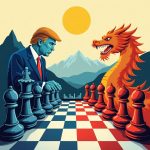Welcome, dear readers of iNthacity.com, the "Shining City on the Web." Today, we're diving deep into the geopolitical ballet directed by none other than Donald J. Trump and how his government swung the tariff cudgel with aplomb. Our focus? The grand trifecta: China, Canada, and Mexico—the incredulous companions in America’s transnational dance of trade. Our muse for this reflection? The erudite insights from Peter Zeihan from Zeihan on Geopolitics.
The Chinese Conundrum: More Than Just Tariffs
An era of soaring tempers and trade tantrums marked the initial plans set forth by Trump, who suggested imposing steep tariffs on China’s staggering half-a-trillion-dollar merchandise exports to the U.S. This notion might seem like a tantrum to some, but it's a calculated move to reset the global trade scales. Imagine Americans bearing an extra cost—like a membership fee for the "Tariff Club"—up around $800 per year per household. Yes, the price of joining this club is steep, but collective resolve can sometimes set us free from economic bondage.
Why target China first? Simple. America has never been under illusions of camaraderie with China. In this intricate game of global chess, each pawn pushed forward alters the playboard. To truly grasp the situation, one must consider China's meticulously honed predatory trade practices. These have long been an open secret, hidden in plain sight. Trump aimed to reroute these flows, enforcing tariffs not only as a stick but as a potential carrot to entice industry back home. But here's the catch—America’s historical struggle to craft a viable alternative plan endures.
Trade Policy: The Maze of Tariff and Industrial Strategy
The challenge, akin to unraveling the most deliciously diabolical maze, is that redirecting trade shouldn't solely involve punishment. Rather, it should be about cultivating a robust domestic industrial landscape. So, what happens when the Chinese worm turns? Or rather, if America tries to spin a new thread of international trade?
Understand this: China doesn’t act alone. Its trade triumphs are bolstered by an ocean of subsidies, keeping industries afloat in what would otherwise be turbulent economic seas. If those subsidies dry up, China might face deindustrialization, a shift as likely as the sky falling.
If the tariffs are to serve their greater purpose, they must couple with an industrial strategy that reclaims and nurtures capabilities. Here's where opportunities blossom like desert wildflowers after a storm. Electronics assembly, materials processing, and more hold potential to reshape American manufacturing prowess. Ironically, America boasts the cheapest natural gas in the world, sparking an epic revival in chemical production—albeit slowly and organically over 15 years.
The Power of Alternative Paths
Painting this picture requires more than just acrylic and canvas; it needs a strategy rooted in industry recovery. Rebuilding capacities such as aluminum processing or lithium enrichment won't necessarily break the bank—they're low-hanging fruit, ripe for the picking. However, this isn't a free feast. The onus lies on crafting policy pathways to outpace the slow churn of market forces. Yet, how does one encourage the quickening pulse of industry renovation?
A Shift in Geopolitical Realities
Tariffs, when wielded with insight and restraint, hold the potential for transformation akin to making a grain of sand into a pearl. Trump's administration, however, hasn't entirely grasped—or perhaps chosen to—this breadth of tariff policy intricacies. Tariff equals victory—it’s a simplistic formula that demands depth in execution to succeed.
No discussion on trade policies would be complete without unraveling our close-knit relationship and trade tensions with Mexico and Canada. However, untangling that web requires another story for another day.
Conclusion: What does this Mean for You?
To our astute readers, I pose these questions: As global citizens in a tumultuously interconnected economy, what power do tariffs hold over your perceptions of international relations? Are you prepared for the price tag attached to realigning trade realities? And crucially, what freedoms are worth the cost in reshaping our industrial narrative?
Join the conversation below. Become a part of our iNthacity community. Respond, debate, and, like aspirational pioneers, explore the vastness of thought beyond the headlines. Let's chart that course toward clearer waters, celebrating the unity and strength that lies within informed discourse. Until then, stay curious and engaged!
Wait! There's more...check out our gripping short story that continues the journey: The Colossus in the Shadows
Disclaimer: This article may contain affiliate links. If you click on these links and make a purchase, we may receive a commission at no additional cost to you. Our recommendations and reviews are always independent and objective, aiming to provide you with the best information and resources.
Get Exclusive Stories, Photos, Art & Offers - Subscribe Today!


























Post Comment
You must be logged in to post a comment.